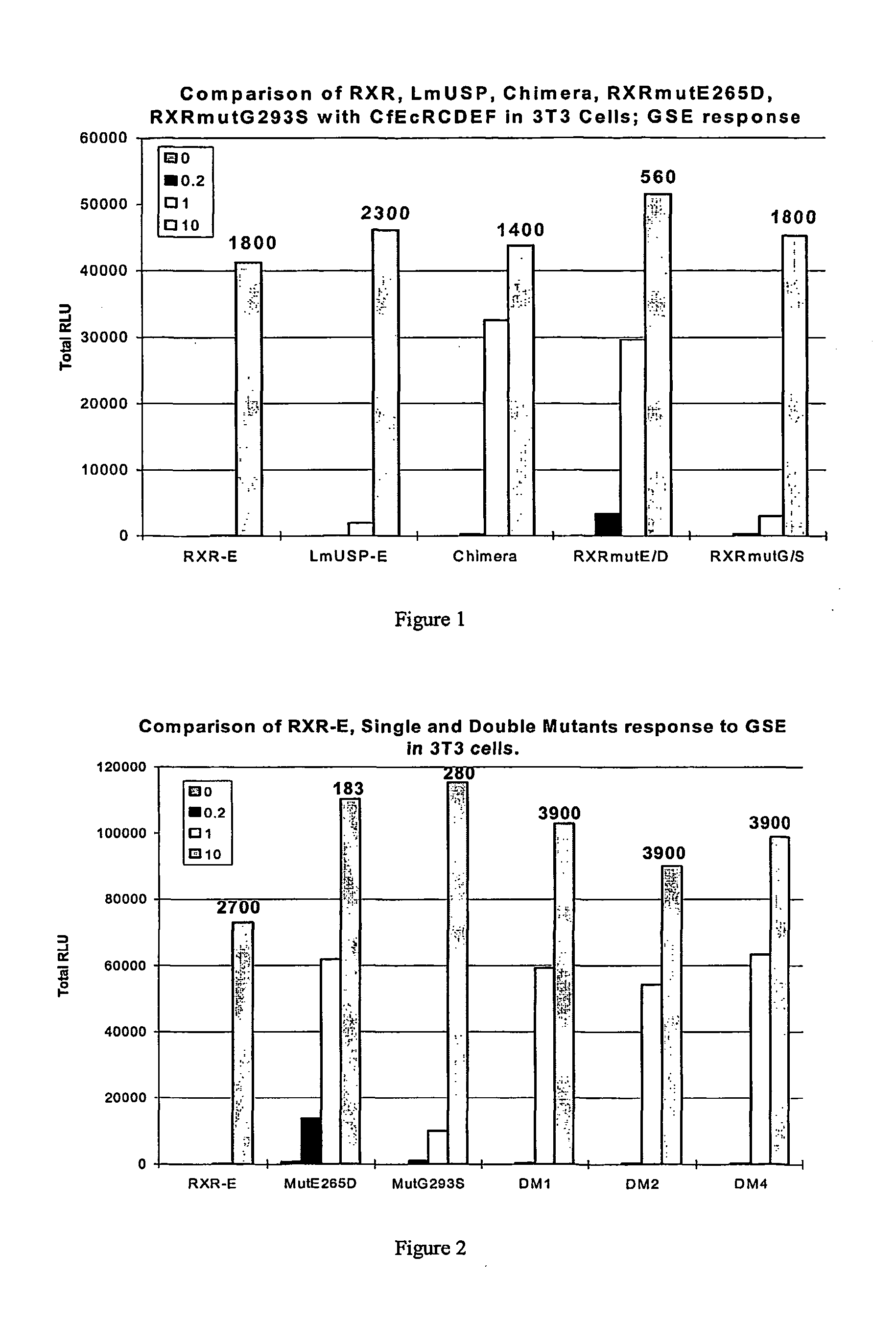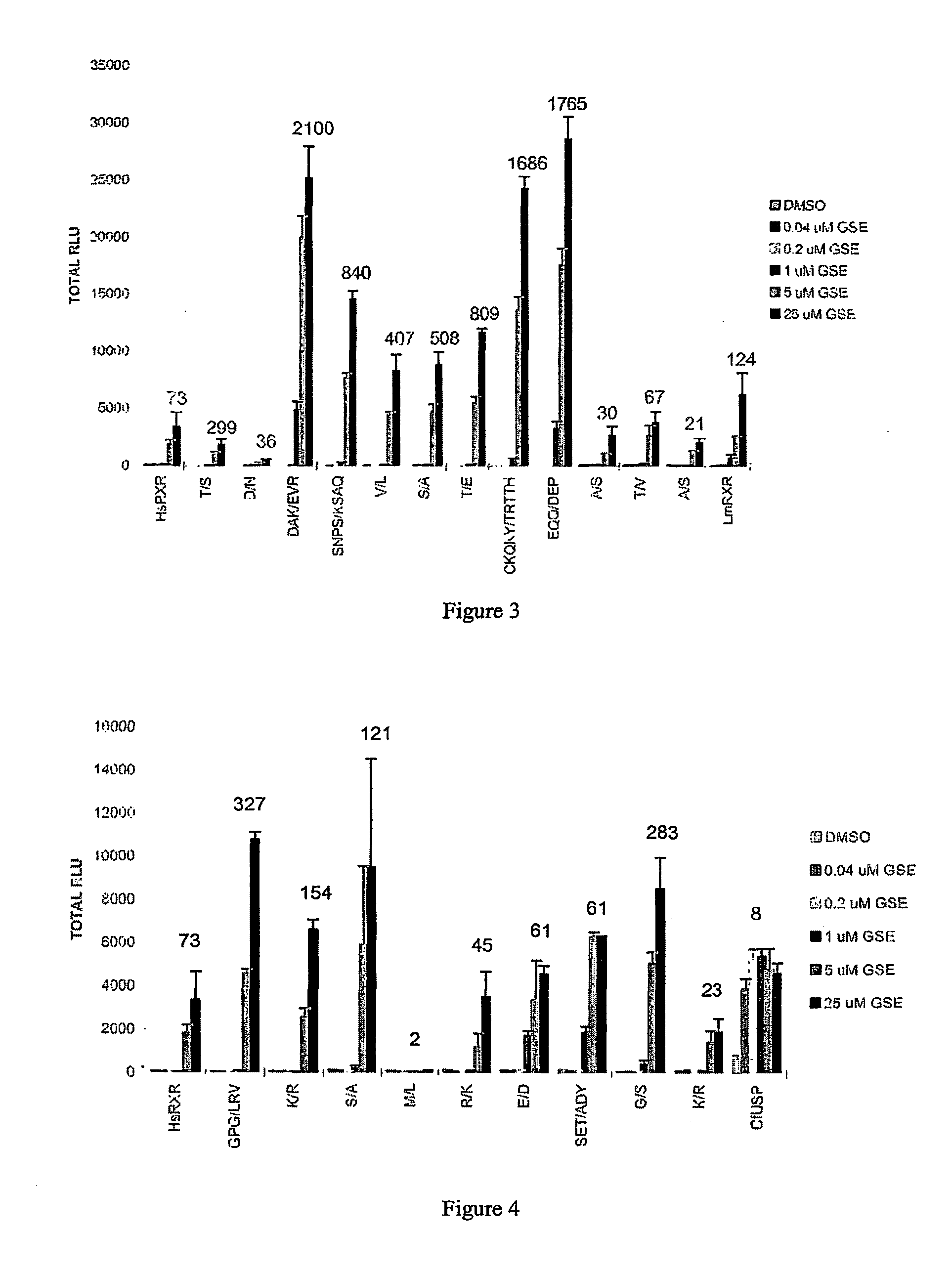Novel substitution mutant receptors and their use in an ecdysone receptor-based inducible gene expression system
a gene expression system and ecdysone technology, applied in nuclear receptors, peptides, fungi, etc., can solve the problems of system limitations, leakage, and limited use of pr1-a
- Summary
- Abstract
- Description
- Claims
- Application Information
AI Technical Summary
Problems solved by technology
Method used
Image
Examples
example 1
[0258]This Example describes the construction of several gene expression cassettes comprising novel substitution mutated Group B nuclear receptor polynucleotides and polypeptides of the invention for use in a nuclear receptor-based inducible gene expression system. Applicants constructed several gene expression cassettes based on the spruce budworm Choristoneura fumiferana EcR (“CfEcR”), mouse Mus musculus retinoid X receptor α (“MmRXRα”), human Homo sapiens retinoid X receptor β (“HsRXRβ”), locust Locusta migratoria ultraspiracle protein (referred to herein interchangeably as “LmUSP” or “LmRXR”), which is an invertebrate RXR homolog of vertebrate RXR, and C. fumiferana USP (“CfUSP”). The prepared receptor constructs comprise a ligand binding domain of either an EcR, an invertebrate USP, a vertebrate RXR, or an invertebrate RXR; and a GAL4 DNA binding domain (DBD) or a VP16 transactivation domain (AD). The reporter constructs include a reporter gene, luciferase or LacZ (β-galactosid...
example 2
[0263]In mammalian cells, the insect (Choristoneura fumiferana) ecdysone receptor (CfEcR) heterodimerizes with ultraspiracle (LISP) or its homolog retinoid X receptor (RXR) and transactivates genes that are placed under the control of cognate response elements. Ligand inducibility of this EcR-based transactivation depends on its heterodimerizing partner. As previously shown by Applicants, transactivation through CfEcR in partnership with insect USPs is ligand independent, whereas transactivation through CfEcR in partnership with invertebrate or vertebrate RXRs is ligand dependent (see pending U.S. patent application 60 / 294,814, incorporated herein by reference in its entirety). Applicants have now discovered that the sequence of RXR can be modified by substitution mutation of the ligand binding domain to influence the magnitude of transactivation as well as ligand sensitivity of an EcR-based inducible gene expression system.
[0264]This Example describes the identification of three Mm...
example 3
[0270]As discussed above, use of an invertebrate RXR, LmUSP (also referred to herein as LmRXR) as a heterodimeric partner for CfEcR improved both the sensitivity and magnitude of induction of a CfEcR-based inducible gene expression system. Applicants have aligned the polypeptide sequences of the LmRXR and HsRXRβ ligand binding domains (domains EF) and identified amino acid residues that are different between these two proteins. This Example describes Applicants' analysis of HsRXRβ substitution mutants in which LmRXR amino acids were substituted in place of the wild-type residues in HsRXRβ. Applicants have now identified several substitution mutants that modify both the sensitivity and magnitude of induction of a CfEcR-based inducible gene expression system in mammalian cells.
[0271]Briefly, Applicants constructed and analyzed substitution mutants in human RXR isoform β-EF (HsRXRβ-EF), wherein amino acids that are different in HsRXRβ-EF compared to the invertebrate RXR homolog LmUSP-E...
PUM
| Property | Measurement | Unit |
|---|---|---|
| Electric charge | aaaaa | aaaaa |
| Electrical conductance | aaaaa | aaaaa |
| Gene expression profile | aaaaa | aaaaa |
Abstract
Description
Claims
Application Information
 Login to View More
Login to View More - R&D
- Intellectual Property
- Life Sciences
- Materials
- Tech Scout
- Unparalleled Data Quality
- Higher Quality Content
- 60% Fewer Hallucinations
Browse by: Latest US Patents, China's latest patents, Technical Efficacy Thesaurus, Application Domain, Technology Topic, Popular Technical Reports.
© 2025 PatSnap. All rights reserved.Legal|Privacy policy|Modern Slavery Act Transparency Statement|Sitemap|About US| Contact US: help@patsnap.com



